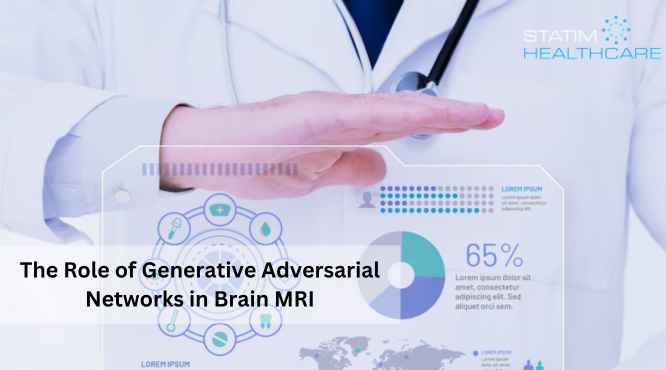In the world of machine learning and data science, the performance of artificial intelligence (AI) is pushing the boundaries for innovative solutions within the healthcare sector. One of the most recent developments in the US medical imaging and healthcare sector is generative adversarial networks (GANs), showcasing its potential in generating synthetic MRI data, capable of capturing distribution of real MRI. GANs are used for segmentation, noise removal, and super-resolution of brain MRI images, works by training two neural networks to compete against each other to create more authentic new data from a given training dataset. In this system, one network creates artificial images, while the other network continuously learns to differentiate between real and generated images.
What is a GAN?
Generative Adversarial Networks (GANs) is a deep machine learning architecture that uses two trained neural networks known as discriminator and generator. It is employed to produce real fresh data from a supplied training set. The discriminator gains the ability to distinguish between actual and fake data, while the generator creates fictional data, such as fake photographs. As unsupervised learning models, GANs are able to learn from unlabeled data and may keep training themselves beyond the first input.
Here are some steps for training a GAN:
- Define a problem
- Select architecture of GAN
- Train discriminator on real dataset
- Train generator
- Train discriminator on fake data
- Train generator with the output of discriminator
What are the Different Use Cases of Generative Adversarial Networks?
The GAN architecture offers several applications across various industries. Some of the examples are as follows:
Generating Images
Realistic graphics may be produced by either creating new images based on text prompts or altering preexisting images using generative adversarial networks (GANs). Digital entertainment, diagnostic health care imaging and other visual experiences may make use of these lifelike pictures. Additionally, GANs may be used to modify photos, producing realistic images, characters, as well as improving the resolution of low-quality photographs and adding color to black-and-white images.
Generating Training Data for Other Models
In the field of machine learning, data augmentation is crucial for increasing the training dataset’s size by creating modified copies of the existing data. Generative models like GANs can be used for data augmentation to generate synthetic data that possesses all the attributes of real-world data. This synthetic data can be employed, for example, in training fraud-detection systems to distinguish between fraudulent and genuine transactions accurately.
Completing Missing Information
Generative models can be trained to accurately predict and fill in missing information within a dataset. For instance, GANs can be trained to generate images of the sub-surface by understanding the correlation between surface data and underground structures. In top medical diagnostic imaging, GANs can create new ones using artificial data disease diagnosis and treatment planning.
Generating 3D Models from 2D Data
GANs have the capability to generate 3D models from 2D photos or scanned images. This functionality is particularly popular in diagnostic imaging in USA, where GANs combine X-rays and other body scans to create realistic images of organs for surgical planning and simulation.
How Generative Adversarial Network Works?
A GAN system comprises two deep neural networks – the generator network and the discriminator network. These networks are trained where one network tries to generate new data and the other network attempts to predict if the output is fake or real data.
Technically, the Generative Adversarial Networks (GANs) works as follows:
- The generator neural network analyzes the training set to understand the data attributes.
- The discriminator neural network also analyzes the initial training data, focusing on distinguishing between the different attributes.
- The generator modifies some data attributes by adding noise (random changes) to create new data.
- The generator then passes the modified data to the discriminator.
- The discriminator calculates the probability that the generated output belongs to the original dataset (real or fake).
- The discriminator provides feedback to the generator to help it improve its generation process in the next cycle.
A scoping review of 139 studies that used GANs for brain MRI data between 2015 and 2021 found that the most common GANs used were cycleGAN, conditional GAN, and Wasserstein GAN. Other types of GANs reported in more than one study include deep convolutional GAN, unified GAN, and Pix2Pix GAN.
Benefits of GANs in Diagnostic Health Care
More Data for Analysis
MRI scans can be limited due to privacy concerns or time constraints. GANs can generate new, realistic images to supplement existing data, allowing researchers to study brain structures in more detail.
Data Augmentation
For certain tasks, like training other AI models for brain analysis, GANs can create variations of existing MRI scans. This helps the AI models become more robust and adaptable to different brain appearances.
Privacy Protection
GANs can generate synthetic MRIs that contain all the essential details for research purposes, while protecting the privacy of real patients by not using their actual scans.
While GANs are a powerful tool, it’s important to remember that the generated images are not real patient data. They should be used cautiously and always be distinguished from actual MRIs.
Enhance Your Diagnostic Imaging Analysis with Statim-Healthcare RIS
We understand the transformative power of generative adversarial networks (GANs) in brain MRI analysis. But complex workflows can slow progress. Our state-of-the-art, US FDA-approved Radiology Information System (RIS) streamlines your GAN-powered analysis, maximizing efficiency and accuracy.
Why Choose Us:
- Seamless Integration: Integrate your GAN analysis tools flawlessly with our RIS.
- Data Management Made Easy: Manage and organize your brain MRI data efficiently for faster analysis.
- Enhanced Workflow: Streamline your diagnostic process, allowing radiologists to focus on what matters most: patient care.
Get in Touch
We are a global leading US FDA approved Radiology Information System (RIS), empowering hospitals and diagnostic centers with knowledge-based solutions. Get in touch to see how our RIS integrates the best generative adversarial networks for brain MRI analysis and other medical diagnostic imaging in USA and globally.

